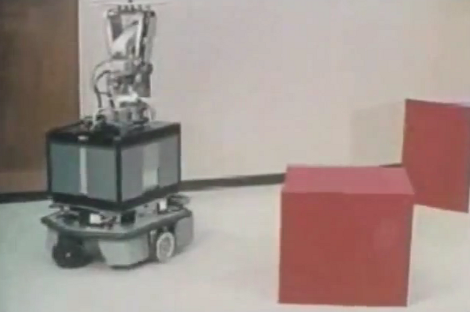
In this installement of Retrotechtacular we’re taking a look at Shakey, a robot developed between 1966 and 1972 at the Stanford Reserach Lab. This was a glorious time when students had long hair but still wore long sleeves and ties to do their research.
The robot is actually communicating wirelessly with the PDP-10 computer which handles the processing. No computer monitor is used for interacting with the robot. Instead, a teletype machine lets you type out your commands on paper, and the response from the machine is printed back to you on the same sheet. There’s a camera which is used for image recognition, and sensors that give feedback when the body comes in contact with an obstacle.
We’d sure love to know what kind of budget this project had, but alas we couldn’t find any info about that. You can go and see Shakey in person if you want to. This info page mentions that the machine is on display at the Computer History Museum in Mountain View, California.















And the music be jammin
Al Jarreau – take five?
http://www.youtube.com/watch?v=hhq7fSrXn0c
More like
http://www.youtube.com/watch?v=faJE92phKzI
:)
old fart
I was only familiar with the original Brubeck version, thanks for sharing this one with Al, I had never seen/heard it before. Kind of mesmerizing, really.
Let’s see how long it takes for youtube to take it down for using copyrighted music. Progress is a different business these days.
Already happened… at least for German viewers.
I like the way they put the agent of change in a black cape!
meanwhile in the present, this is a challenge done by high school students with $50 in parts and an android mobile phone.
Not even a little bit. No hobby robot I’ve ever seen has the same capabilities the Shakey had.
Shakey was the first robot I ever saw. I was surprised that google isn’t awash with info.
I read an extensive trials and tribulations account from one of the original team a couple of decades ago. There’s a six degrees of separation between this robot and the odetics bubble-bot.
Gist: It was a low budget affair, being slapped together from parts left over from a computer vision project and someone’s “robotic rover” project. I believe most of the original team is still around.
It’s really a fine tribute to engineering and duct tape.
Any info on the wireless?
Standard VHF/UHF radio?
UHF or ~420mc – but that’s pulled from memory. It wasn’t high powered. I looked and cannot find my documents on this, and don’t remember the source. It was written by the principle on the project, or by a student working in the group.
The gist was that the three projects that got bolted together were already done, and more or less available for parts.
The camera and the video digitizer to computer interface was for identifying scenes and shapes, which worked reasonably well for the technology. Machine vision analysis wasn’t very complex at the time, mostly edge detection and object differentiation. It was early days, as they say.
It wasn’t a huge leap of engineering to drop in a RF link instead of a cable, but we shouldn’t trivialize it. It’s a lot of work to sort out, as generations of Ham radio enthusiasts have discovered. But I think they obtained a commercial link and modified it.
The rover was sitting around and had been used like every robot platform before or since. The theory was that we could put it on the moon, but mostly it was a remote control car.
All of these had already had been done as projects, but they* glued it all together for a great demo. New code was written, and proposals hyped, but they did not make money fall from the sky as hoped.
It’s a funny thing about research. Sometimes money falling from the sky is the last thing you need. Look at the budget requests – very pie in the sky for that time, . The project itself was not a tour de force, but it inspired a lot of subsequent work.
The cost to meet the performance goals of this project today would be a few hundred dollars. And yet, regardless of what you built, it would not be half as cool.
ok, feeling really old now!
I have the Byte issue where there is a great write up of this robot.
Circa 1976 byte magazine had a strong robotics bent, and either the first or third issue had a series of articles about an equally cool robot that shifted blocks around… followed by an article about a robotic frog vision/grasper system. I immediately tried to duplicate these.
There was also an episode of Nova from about the same decade that featured SHRDLU, Shakey and a dozen other half-baked robotic experiments. The funny thing is that everything is there to build fairly sophisticated robots for <$500, or even less for the careful scrounger.
I wish had more time.
I remember reading about this in a robotics book in elementary school and being fascinated ( I was an odd little kid ).
We can do all this for much less nowadays, it is true. But we have hardly moved at all to get robots to actually think for themselves.
Miroslav,
if we cannot do it for people, we cannot hope to do it for robots.
But you will see autonomous robots appear for consumers within your lifetime. They are very close, only lawyers prevent it.
love the haircuts !!!
My own little tribute page, with links to so interesting stuff:
http://techref.massmind.org/Techref/robot/shakey.htm